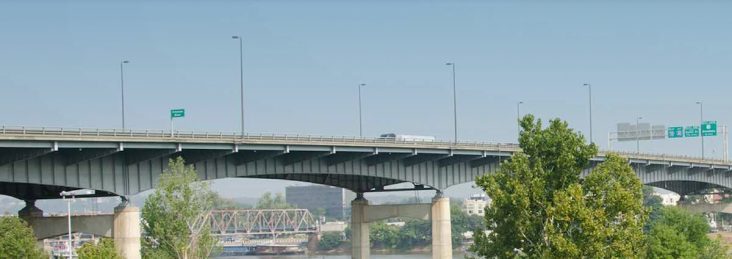Opposing views about I-30 expansion plan aired in respectful town hall
by November 16, 2015 11:10 pm 336 views

Town hall participants questioned the need for the 10-lane I-30 Crossing across the Arkansas River at the Clinton Presidential Center Monday, while some offered their support for the project.
The project will replace the six-lane I-30 bridge across the Arkansas River with six new lanes plus two connector/distributor lanes moving in both directions that are designed to ease the transition on and off the interstate.
Garver’s Jerry Holder, the project manager, said planners weighed four factors equally: mobility, safety, cost, and environmental impacts. The corridor has a high accident rate, doesn’t have adequate shoulders, and one of its piers is not aligned with other bridges in Little Rock, leading to barge accidents.
He said planners started with 43 alternatives that went through a screening process. Early casualties included dedicated truck lanes because heavy trucks compose only 6% of traffic over that bridge, and light rail, which was projected to carry only 6,500 daily riders in 2040. Six-lane alternatives were found to be inadequate, while a 12-lane scenario was too costly and would cause too much harm to the environment.
Planners eventually settled on a project that would replace the six-lane bridge while adding the four connector-distributor lanes, which are separated from the rest of the interstate by concrete barriers. A big advantage of the plan is that it will allow six lanes to remain open throughout construction, which is expected to begin in 2018 and last about four years. Improvements will be made to other roads, including doubling from one lane to two the entrance onto I-30 from I-530 coming from Pine Bluff and the replacement of left-hand exists in the I-30/I-40 interchange.
In addition to five previous public meetings, planners with Garver and the Arkansas Highway and Transportation Department have had about 80 meetings with homeowners’ associations, civic clubs and others. Engineers have evaluated the project for its impact on the area. Of 45 historic sites in the study area, only one will be impacted, a historic but structurally deficient bridge that will be replaced, Holder said. More than 5,000 shovel tests and 80 auger tests have been performed looking for culturally significant sites. There are nine acres in the right of way and five residences and seven commercial locations that will be impacted.
Planners have tried to respond to residents’ concerns. Among those were complaints that an earlier plan would have disrupted the eastern route of the city’s trolley system. Those plans have been changed to protect the trolley. Planners are taking a second look at an eight-lane alternative. Other ideas, such as converting I-30 to a boulevard, were not feasible, Holder said.
The town hall’s 200 attendees were given three minutes each to talk, and 28 did. Most expressed opposition to the project, followed by applause from some in the audience, but the tone remained constructive and respectful. Many said a 10-lane interstate isn’t needed and said the AHTD isn’t taking a long enough view or looking for other forms of transportation. Steve Clark with the League of American Bicyclists said, “You get what you design for” and said other cities have been able to reduce vehicle miles traveled.
Architect Tom Fennell said other cities are moving away from huge freeways and said the plan does nothing to lessen demand. He asked why I-440, which bypasses Little Rock, was constructed if it’s not going to be used.
Several community leaders expressed support for the plans, including Jay Chesshir, president and CEO of the Little Rock Chamber of Commerce, and Frank Thomas with Stephens Inc., who said it would benefit the firm’s 500 employees who commute to work from outside of Little Rock. Sen. Linda Chesterfield, D-Little Rock, said the plan would benefit her constituents who live in Little Rock and its outskirts who must drive through the congested roadway.
Including nearby improvements, the cost of the entire I-30 corridor project is $650 million. The project is being funded by the half-cent sales tax passed by voters in 2012. The public comment period ends Dec. 6.
